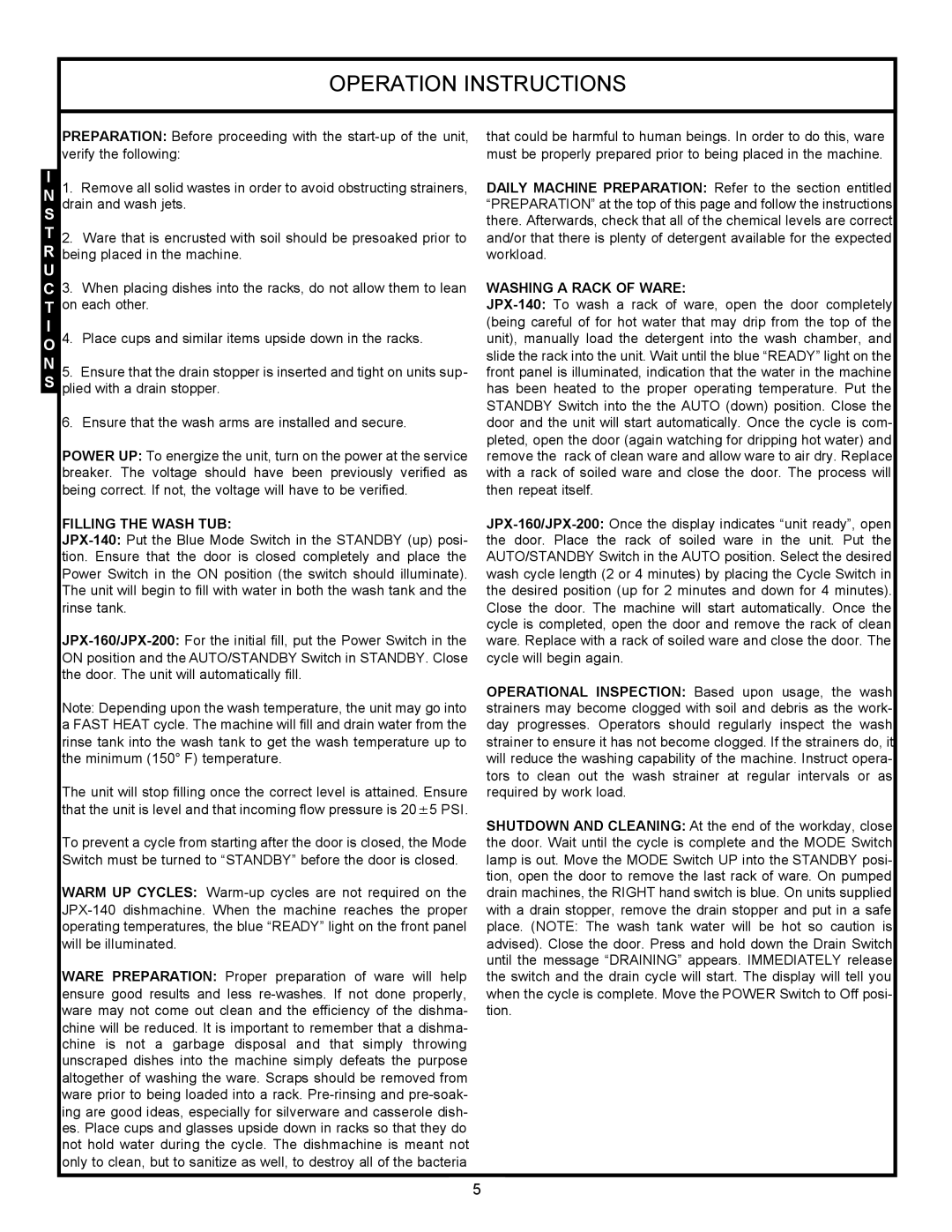PREPARATION: Before proceeding with the start-up of the unit, verify the following:
I
N 1. Remove all solid wastes in order to avoid obstructing strainers, S drain and wash jets.
T2. Ware that is encrusted with soil should be presoaked prior to R being placed in the machine.
U
C 3. When placing dishes into the racks, do not allow them to lean T on each other.
I
O4. Place cups and similar items upside down in the racks.
N5. Ensure that the drain stopper is inserted and tight on units sup- S plied with a drain stopper.
6.Ensure that the wash arms are installed and secure.
POWER UP: To energize the unit, turn on the power at the service breaker. The voltage should have been previously verified as being correct. If not, the voltage will have to be verified.
FILLING THE WASH TUB:
JPX-140:Put the Blue Mode Switch in the STANDBY (up) posi- tion. Ensure that the door is closed completely and place the Power Switch in the ON position (the switch should illuminate). The unit will begin to fill with water in both the wash tank and the rinse tank.
JPX-160/JPX-200:For the initial fill, put the Power Switch in the ON position and the AUTO/STANDBY Switch in STANDBY. Close the door. The unit will automatically fill.
Note: Depending upon the wash temperature, the unit may go into a FAST HEAT cycle. The machine will fill and drain water from the rinse tank into the wash tank to get the wash temperature up to the minimum (150° F) temperature.
The unit will stop filling once the correct level is attained. Ensure that the unit is level and that incoming flow pressure is 20A5 PSI.
To prevent a cycle from starting after the door is closed, the Mode Switch must be turned to “STANDBY” before the door is closed.
WARM UP CYCLES: Warm-up cycles are not required on the JPX-140 dishmachine. When the machine reaches the proper operating temperatures, the blue “READY” light on the front panel will be illuminated.
WARE PREPARATION: Proper preparation of ware will help ensure good results and less re-washes. If not done properly, ware may not come out clean and the efficiency of the dishma- chine will be reduced. It is important to remember that a dishma- chine is not a garbage disposal and that simply throwing unscraped dishes into the machine simply defeats the purpose altogether of washing the ware. Scraps should be removed from ware prior to being loaded into a rack. Pre-rinsing and pre-soak- ing are good ideas, especially for silverware and casserole dish- es. Place cups and glasses upside down in racks so that they do not hold water during the cycle. The dishmachine is meant not only to clean, but to sanitize as well, to destroy all of the bacteria
that could be harmful to human beings. In order to do this, ware must be properly prepared prior to being placed in the machine.
DAILY MACHINE PREPARATION: Refer to the section entitled “PREPARATION” at the top of this page and follow the instructions there. Afterwards, check that all of the chemical levels are correct and/or that there is plenty of detergent available for the expected workload.
WASHING A RACK OF WARE:
JPX-140:To wash a rack of ware, open the door completely (being careful of for hot water that may drip from the top of the unit), manually load the detergent into the wash chamber, and slide the rack into the unit. Wait until the blue “READY” light on the front panel is illuminated, indication that the water in the machine has been heated to the proper operating temperature. Put the STANDBY Switch into the the AUTO (down) position. Close the door and the unit will start automatically. Once the cycle is com- pleted, open the door (again watching for dripping hot water) and remove the rack of clean ware and allow ware to air dry. Replace with a rack of soiled ware and close the door. The process will then repeat itself.
JPX-160/JPX-200:Once the display indicates “unit ready”, open the door. Place the rack of soiled ware in the unit. Put the AUTO/STANDBY Switch in the AUTO position. Select the desired wash cycle length (2 or 4 minutes) by placing the Cycle Switch in the desired position (up for 2 minutes and down for 4 minutes). Close the door. The machine will start automatically. Once the cycle is completed, open the door and remove the rack of clean ware. Replace with a rack of soiled ware and close the door. The cycle will begin again.
OPERATIONAL INSPECTION: Based upon usage, the wash strainers may become clogged with soil and debris as the work- day progresses. Operators should regularly inspect the wash strainer to ensure it has not become clogged. If the strainers do, it will reduce the washing capability of the machine. Instruct opera- tors to clean out the wash strainer at regular intervals or as required by work load.
SHUTDOWN AND CLEANING: At the end of the workday, close the door. Wait until the cycle is complete and the MODE Switch lamp is out. Move the MODE Switch UP into the STANDBY posi- tion, open the door to remove the last rack of ware. On pumped drain machines, the RIGHT hand switch is blue. On units supplied with a drain stopper, remove the drain stopper and put in a safe place. (NOTE: The wash tank water will be hot so caution is advised). Close the door. Press and hold down the Drain Switch until the message “DRAINING” appears. IMMEDIATELY release the switch and the drain cycle will start. The display will tell you when the cycle is complete. Move the POWER Switch to Off posi- tion.

